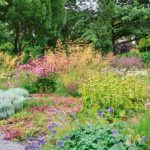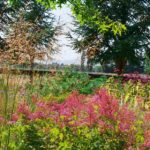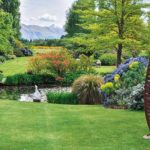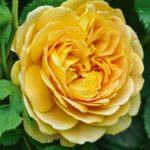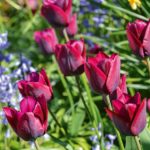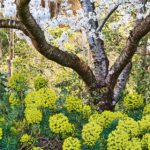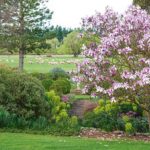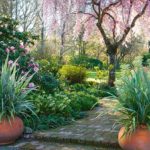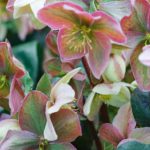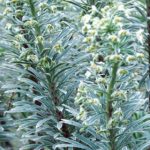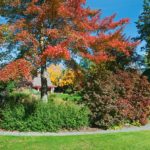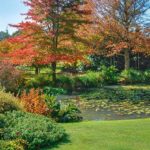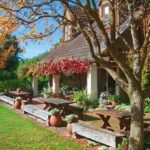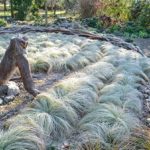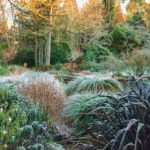Canterbury’s Flaxmere Garden through the seasons
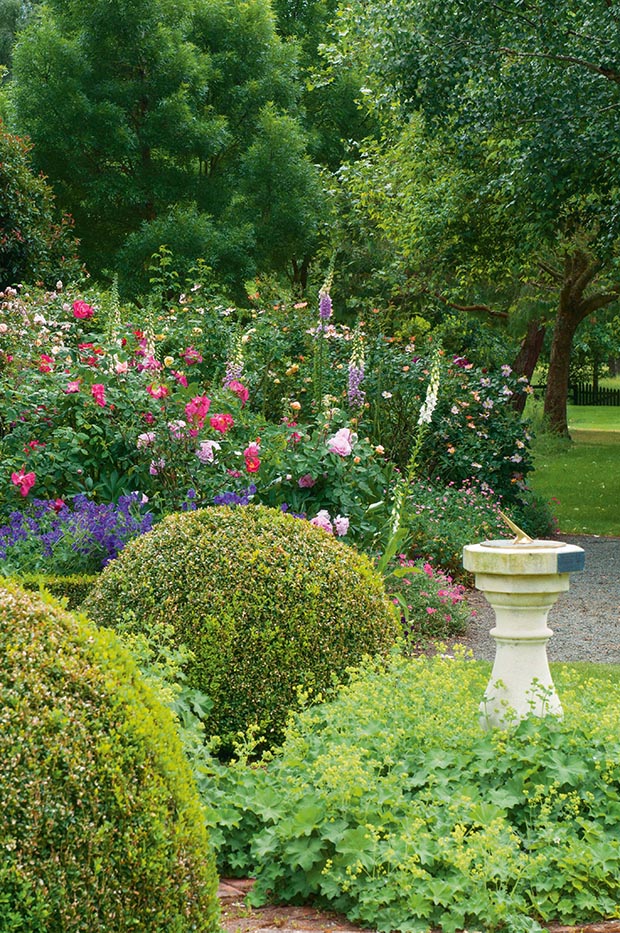
Summer: the rose garden is planted in blocks of red, pink, yellow, white and purple around the sundial.
Drought, ferocious winds and extreme temperatures aren’t ideal conditions in which to create a garden. Half a century after Penny Zino started Flaxmere, the work on this award-winning property is still not over.
Words: Grant Mangin Photos: Juliet Nicholas
Penny Zino isn’t quickly reduced to tears, yet some days in her Garden of National Significance can be a challenge. One late-winter morning, just eight weeks before she was due to greet 2000 visitors (Flaxmere is annual host to the four-day Art in a Garden festival in north Canterbury), she woke to discover 100 bulls ambling through the grounds.
“I was struggling to hold back the tears,” she says. “Flaxmere is part of a busy farm, and that means livestock are always looking over fences with grass-is-greener eyes at the luscious borders and elegant lawns. “Over the years there have been mobs of sheep getting into the garden and helping themselves, but the bulls were much worse. They had been everywhere; plants were trampled and branches were broken. And, to make matters even worse, it had rained heavily in the days prior and so the weight of the bulls caused unbelievable damage to the lawn. I couldn’t believe what I saw.”
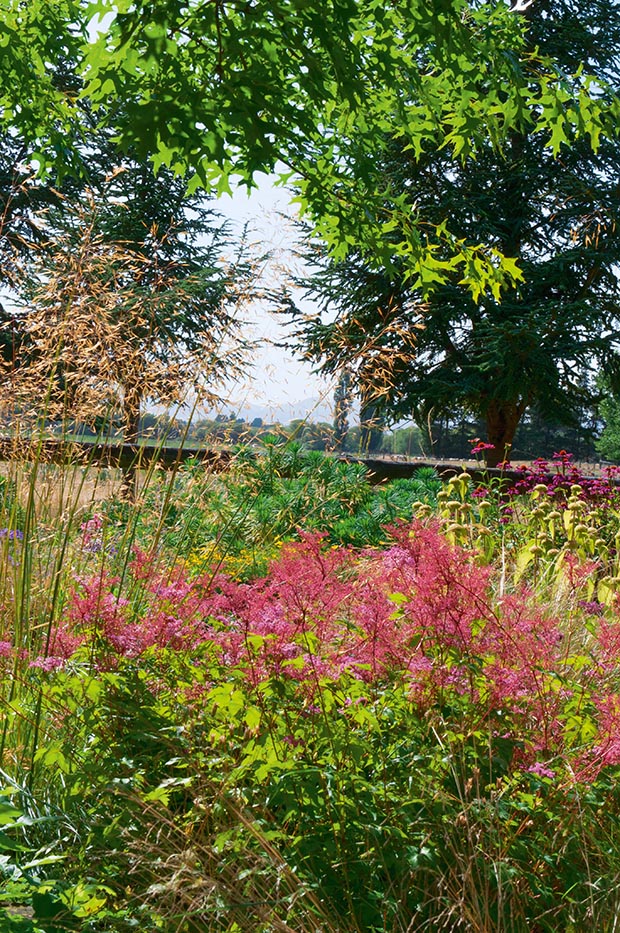
Flaxmere Garden in summer.
Tears of frustration may have flowed on this occasion, yet marauding livestock isn’t the only challenge Penny has overcome in her 50 years of gardening. Flaxmere, inland from Hawarden in the Hurunui district and covering 3.2 hectares, endures North Canterbury’s legendary ferocious northwesterly winds. The winds wrench branches from trees and send summer temperatures soaring, sometimes reaching 40 degrees Celsius. Heat and wind like this turns the soil to dust. Conversely, winter conditions (down to minus-15 Celsius) can produce frosts that lift new plants right out of the ground.
The climate extremes go hand-in-hand with drought. Over the past three years, record-breaking droughts have killed many large established trees and stunted the growth of countless other trees and plants. It’s not an ideal location for a farm, let alone an award-winning garden.
- The rose garden planted in blocks of red, pink, yellow, white and purple.
- The colour palette goes extreme in the adjacent perennial garden.
- The fluorescent pink flowers of Echinacea purpurea contrast with the purple-blue geranium.
- “There’s something special about the scent of old-fashioned roses that lures you to the rose garden before you see it,” says Penny.
- Roses in summer.
But Penny’s decision to create the garden was a pragmatic response to difficult personal circumstances when her eldest son Mark was diagnosed with severe asthma. A home nebulizer was required so Mark could receive urgent treatment during an attack. Penny decided to look for a project to keep her close to Mark at all times, and there it was, the ideal one, within view of her kitchen window.
“I realized I could be more ambitious with the garden and go further. We’d already cleared the macrocarpas and pines from around the farmhouse, and started planting roses, viburnum, chimonanthus (wintersweet), grevillea, laurustinus and wild lilac. I could see a tremendous vista of Mount Te Koa to the north of the house, and it was the inspiration I needed to get started.”
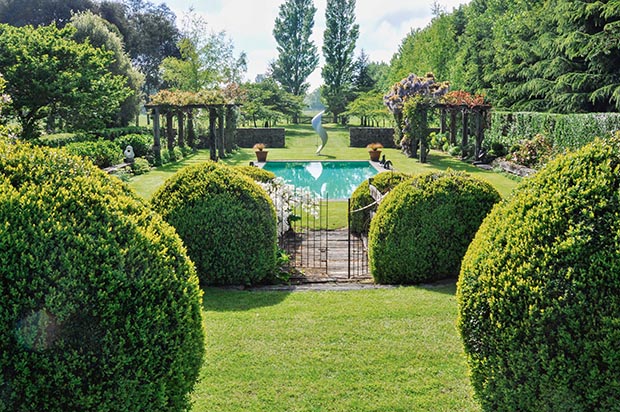
Penny keeps a watchful eye on a blue wisteria draped over the pergola in the swimming pool garden. “It’s early flowering and can get knocked about by late frosts. It only flowers two out of every five years, but when it does, it’s magnificent.”
Today, that northern view to Mount Te Koa, overlooking lawns separated by a pond with a gently arched bridge, is the principal of three vistas seen from the house. To the east is a view of the swimming pool garden with its classically inspired formal stone walls, built by Penny from river stones collected from across the farm, and wooden pergolas built by husband John from salvaged bridge timbers. The pergolas are draped in native Clematis paniculata and Clematis montana ‘Marjorie’ with its green-yellow flowers, and rambling roses, including the climbing ‘Crepuscule’, ‘Alister Stella Grey’ with it yellowy flowers and ‘Devoniensis’, also known as the ‘Magnolia Rose’, which releases a gorgeous scent.
The western view follows a brick path to the former tennis court lawn (these days used for wedding marquees) with an elongated pond parallel to the path. Penny’s younger son Sam designed and excavated the pond. Building his design involved him sitting on a stool in the pond, measuring the height from the surface of the water to ensure the brick topping was level. Mature rhododendrons grow by the tennis court lawn, with a mass planting of hydrangeas under the elm. Nearest the house are roses, irises, tulips, crocuses, and snowdrops. On either side of the path is one of Penny’s favourite trees – the crab apple Malus ioensis ‘Plena’.
“The crab apples fulfil all my aspirations for small trees,” says Penny. “They have wonderful double flowers opening late in spring. They produce little green crab apples in summer, have fabulous autumn colour and interesting bark in the winter; it’s a tree for all seasons.”
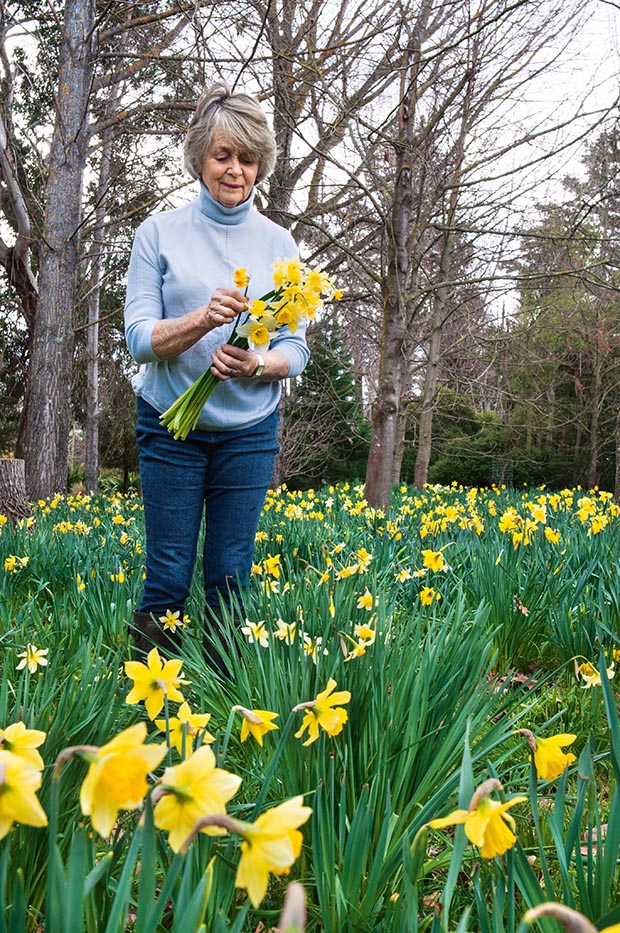
“I was given a bag of old-fashioned daffodils about 45 years ago,” says Penny. “I love their long stems and elegant trumpets, and now they’ve self-seeded, so there are thousands of them beneath the trees.”
Selecting plants for all seasons has been deliberate, as has choosing species that cope with the extreme climatic conditions at Flaxmere. Grevillea rosmarinifolia, an Australian native, was selected for its tolerance of dry conditions and its spectacular red-pink flowers full of nectar that attract the New Zealand bellbird. Abelia shrubs are used throughout the garden and flower from late spring through to autumn. They are one of a number of older, traditional shrubs and trees that fell from favour in modern gardens but are used extensively at Flaxmere, where function triumphs over fashion every day.
Take the strawberry tree Arbutus unedo. It is rarely seen in contemporary gardens. But in Penny’s books, it’s a keeper. “People have forgotten the strawberry tree, but it has everything going for it. It’s evergreen, with white flowers and edible fruit, which the birds love. Best of all it’s as tough as anything and will tolerate dry summer conditions and just keep on growing.”
- Tulips in spring.
- One of Penny’s favourite walks in spring takes her from the farmhouse, past the crab apple trees, the flowering camellias and astelia in pots to the woodland area carpeted in daffodils.
- A public tour in spring.
Despite the careful choice of robust trees and shrubs, the past three years of drought have wreaked havoc in the garden, with the death of decades-old trees such as the silver birches Betula pendula that had woven their way along the entrance drive into the garden. Even native species such as griselinia have succumbed to drought. Gale-force winds over the same period also brought down trees and damaged branches.
It’s not all bad since Penny views the loss of trees and shrubs as an opportunity. The Whirlpool garden is a recent addition, created in an area originally planted with shelter trees. Snow damage provided Penny with the incentive to clear the area and start again. A damaged gum tree, with its curving branches, inspired a swirling whirlpool effect with massed plantings of native carex grass in concentric circles. In the breeze, the grasses swirl around.
In the early years Penny and John developed Flaxmere as a team; Penny applying her artistic eye to the design and John working to shape and contour the garden and build pergolas and paths. Though son Mark’s asthma had provided the impetus to start the garden, a second shock was in store for Penny when John was diagnosed with terminal cancer in 1993.
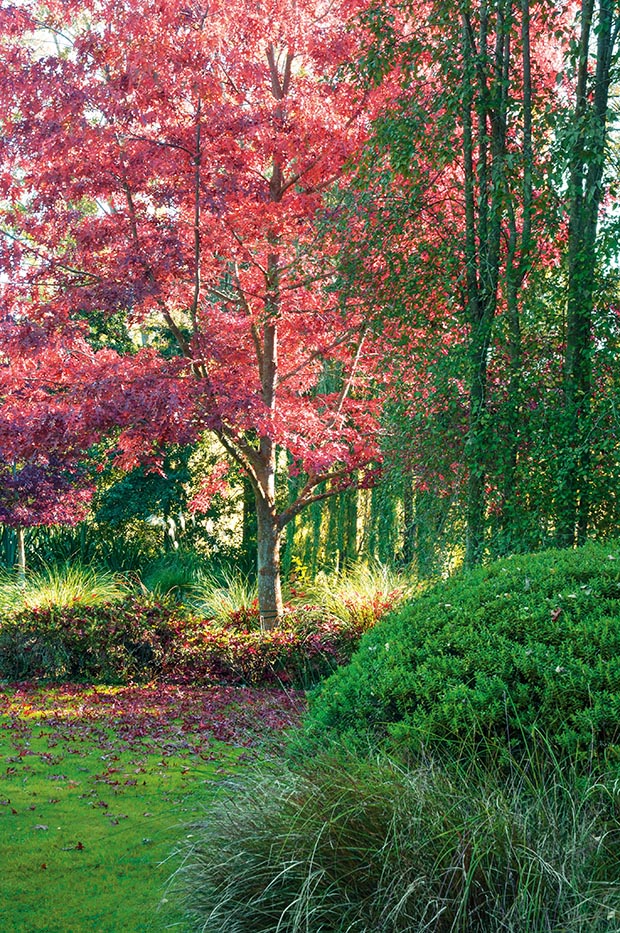
Autumn brings out the genius behind Penny’s garden design. “I used waratahs (metal fencing stakes) with coloured ribbons (green for evergreens, yellow for yellow autumn leaves and red for red leaves) to decide where to plant trees and shrubs for structure and colour balance.
After his death in January 1994 and Penny’s diagnosis with acoustic neuroma (benign ear turmour), Penny and her children all left Flaxmere. Zinio Nurseries partners Max Waller and Leonie Church looked after the garden until Penny recovered from surgery. Her recovery brought her back to benefit from the healing power of the garden. Within a few years all her children also returned to continue its evolution, redeveloping areas such as the Whirlpool and the perennial grass garden. Penny welcomes more than 4000 visitors each year – for the festival, as well as weddings and tour groups.
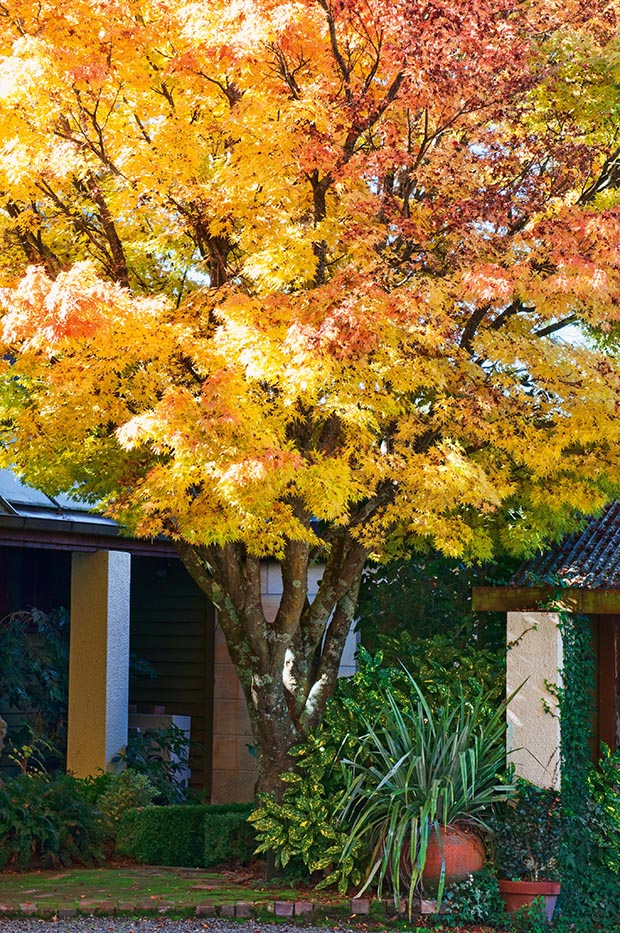
The effective simplicity of Penny’s approach delivers an autumn garden of contrasting and intertwining green, yellow and red tones, reflected in a series of ponds connected by a stream.
“The most challenging time was after John died. I was so lucky to have had a supportive husband who encouraged me and believed in my ability, and most of all understood the passion I had to create the garden. I’m very lucky because my children returned to live nearby and wanted to support me in building a new life at Flaxmere. I love spending time with my three children, their partners, and eight grandsons. We all enjoy this wonderful garden.”
THE GARDEN BECOMES A PRECIOUS NURSERY
Penny isn’t precious about her garden. When, in the late 1980s, rural New Zealand was affected by the economic downturn, Penny put the garden to use to supplement the farm income. About 7500 square metres was turned over to growing gypsophila. “In 1985 five stems of gypsophila – that’s a bunch – were worth $12. A lamb was selling for $6. It’s hard to believe a carload of gypsophila was worth more than a truckload of lambs, but that’s how it was.”
The success with fresh gypsophila provided the impetus to move into commercial propagation, and Flaxmere became a productive and profitable nursery over the next decade, supplying climbers and old-fashioned roses to retail nurseries and individual customers throughout New Zealand. With improving farm returns, the commercial nursery was wound down, though the old-fashioned rose garden is a sweet-scented reminder of when the garden helped the farm’s finances.
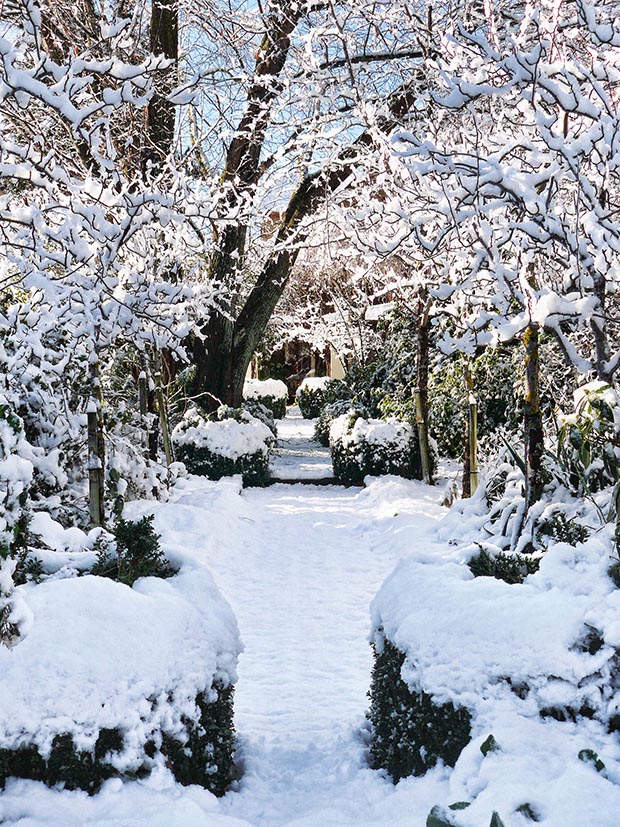
“The light is so soft in winter it bathes the garden giving it an ethereal feel,” says Penny.
THE GARDEN IN THE COMMUNITY
Penny has always believed in supporting her local community. When the local ski club faced hardship after a poor season, the Zinos, along with other local garden owners, ran a couple of garden tours to fundraise for the ski club. They were so successful that the decision was made in 1985 to form a group called the Country Gardens Collective to attract tour groups and conference attendees. The collective’s tours provided employment and income for family, friends and locals and raised funds for charity. Thirty years on and Flaxmere Garden is now part of the Hurunui Gardens Group, continuing the tradition of opening gardens to the public for tours in spring.
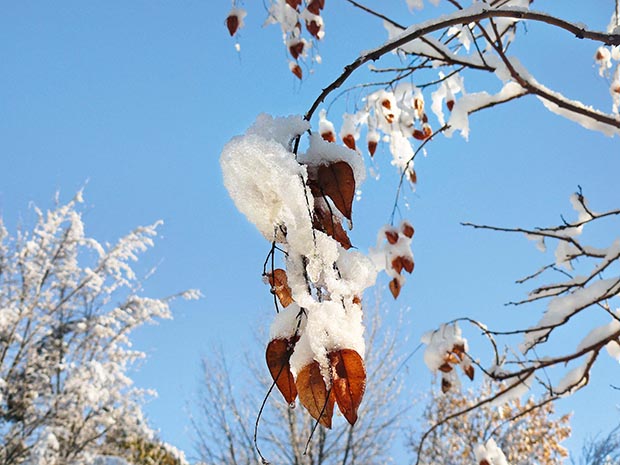
Winter is a special time at Flaxmere. Time seems to stand still after a heavy frost.
Penny was to apply the same approach when she and good friend Ali Meyer set up the Art in a Garden event, which showcases New Zealand sculpture, painting, ceramics, glass and jewellery. They intended to help generate employment and opportunities beyond the show, and also to raise money for charity – about $10,000 most years.
“We wanted the event to work for everyone – the artists, the visitors and buyers – but it also had to pay its costs and deliver something back to the community. We decided to support two charities highly prized in our local community, and chose St John’s and the Cancer Society.”
- “[In winter] the bones of the garden are on view. If it looks good in winter, it’ll look good at any time of the year.”
- Iced-up ponds bemuse the swans unable to make a splash.
- There’s another upside to winter. The shorter days provide time to enjoy the garden’s quiet majesty and plan for its future.
- “I don’t feel guilty about staying in bed on cold mornings, though I’m usually dreaming up the next project,” Penny says.
FIFTY YEARS OF EXTREMES
Penny’s been thinking about writing the story of how she and husband John created Flaxmere Garden for many years, but there’s always been a hold-up – the garden’s not finished. “You never stop thinking about how you could improve it. Every time a tree or shrub dies there’s a choice to be made – replace it with the same, or try something new. I’m constantly inspired by other people’s gardens and find myself looking for ways to experiment and evolve.”
A date on a calendar persuaded Penny the time was right to share her story. It’s 50 years since the couple began clearing the overgrown mass of macrocarpa, ivy and periwinkle from around the farmhouse and planting what would become Flaxmere.
Flaxmere Garden: 50 Years of Extremes, published in October and available at flaxmeregarden.co.nz, tells Penny’s inspirational story of creating the garden, battling with the extreme climate and overcoming personal challenges.
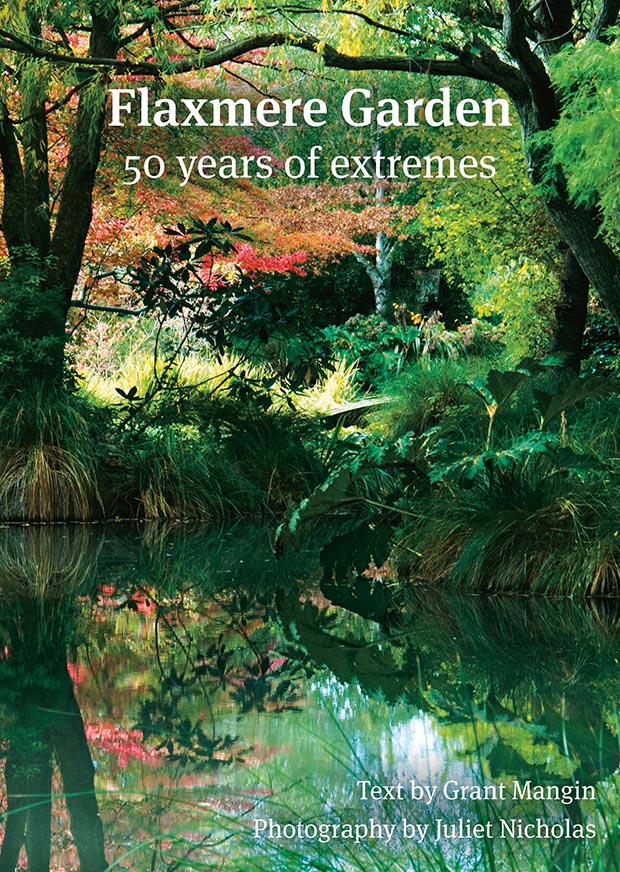
Love this story? Subscribe now!
 This article first appeared in NZ Life & Leisure Magazine.
This article first appeared in NZ Life & Leisure Magazine.
